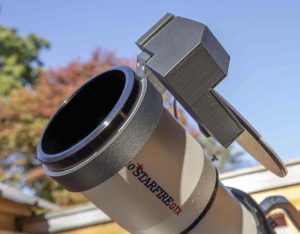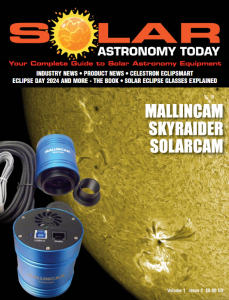The OPTEC Alnitak 270 case upgrade for the Alnitak Flip Flat and Dust Cover allows for 270-degree rotation of the swing arm. This allows the light panel to fully open and stow beside the OTA, reducing the impact of wind gusts and stray light reflections. There is also a custom mounting ring that allows you to replace the zip tie style mounting, providing a secure mounting that will not move or slip if bumped.
 The new accessory is available from Overcast Observatory operated by Chris White, an astro imaging enthusiast who offers a select offering of astronomy accessories. As White notes about the OPTEC Alnitak 270 case upgrade “This is the official OPTEC Alnitak Case upgrade. I’ve worked with OPTEC engineers to modify the firmware and drivers to allow 270-degree rotation and partnered with OPTEC to be the recommended upgrade path for your existing OPTEC Alnitak product. OPTEC is referring existing Alnitak customers who wish to upgrade. Additionally, I will be manufacturing these kits for OPTEC so that their future Alnitak product line natively offers this 270-degree rotation functionality.”
The new accessory is available from Overcast Observatory operated by Chris White, an astro imaging enthusiast who offers a select offering of astronomy accessories. As White notes about the OPTEC Alnitak 270 case upgrade “This is the official OPTEC Alnitak Case upgrade. I’ve worked with OPTEC engineers to modify the firmware and drivers to allow 270-degree rotation and partnered with OPTEC to be the recommended upgrade path for your existing OPTEC Alnitak product. OPTEC is referring existing Alnitak customers who wish to upgrade. Additionally, I will be manufacturing these kits for OPTEC so that their future Alnitak product line natively offers this 270-degree rotation functionality.”
The accessory is produced out of a polycarbonate carbon fiber blend (PCCF) and is light and durable, withstanding high temperatures as well as moisture. The custom dew shield ring is also produced out of PCCF and has a ring liner made of TPU which is a flexible soft material to contact your dew shield. The ring is removable from the Alnitak 270 case, which allows you to easily swap your device from one scope to another as long as all your scopes have a custom mounting ring.
You can learn more about the OPTEC Alnitak 270 case upgrade here.

 And to make it easier for you to get the most extensive news, articles and reviews that are only available in the magazine pages of Astronomy Technology Today, we are offering a 1-year magazine subscription for only $6! Or, for an even better deal, we are offering 2 years for only $9. Click here to get these deals which only will be available for a very limited time. You can also check out a free sample issue here.
And to make it easier for you to get the most extensive news, articles and reviews that are only available in the magazine pages of Astronomy Technology Today, we are offering a 1-year magazine subscription for only $6! Or, for an even better deal, we are offering 2 years for only $9. Click here to get these deals which only will be available for a very limited time. You can also check out a free sample issue here.
The Sun is more active than it’s been in years and if that’s not enough, we have the Annular Solar Eclipse on October 14, 2023 and the Total Solar Eclipse on April 8, 2024! If you’d like to learn more about the technology behind solar observing, solar imaging and more, you can check out our new monthly magazine – Solar Astronomy Today. It’s free to read, no subscription needed and available here. And if you are preparing for the upcoming eclipses and want to know your equipment options from solar glasses to the most out of this world solar viewing and imaging options, check out our free publication – The Definitive Guide to Viewing and Imaging the Sun – simply click here and enjoy reading!

